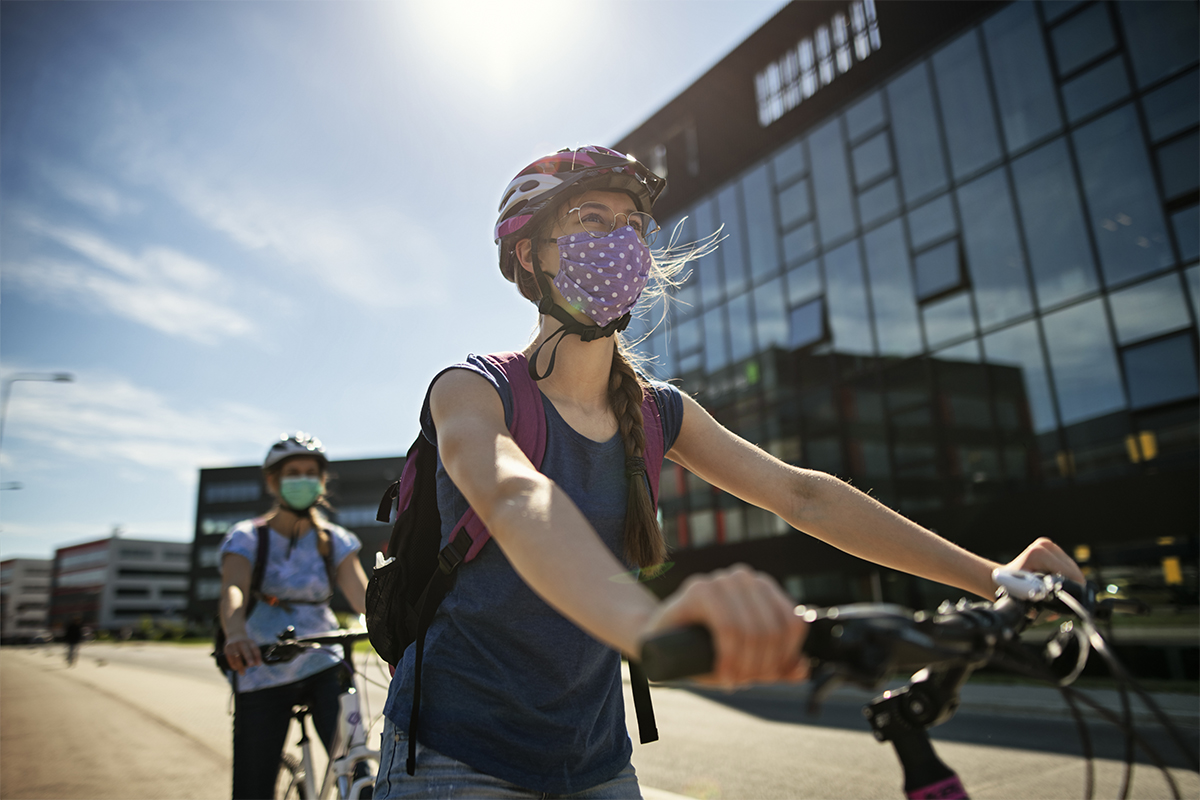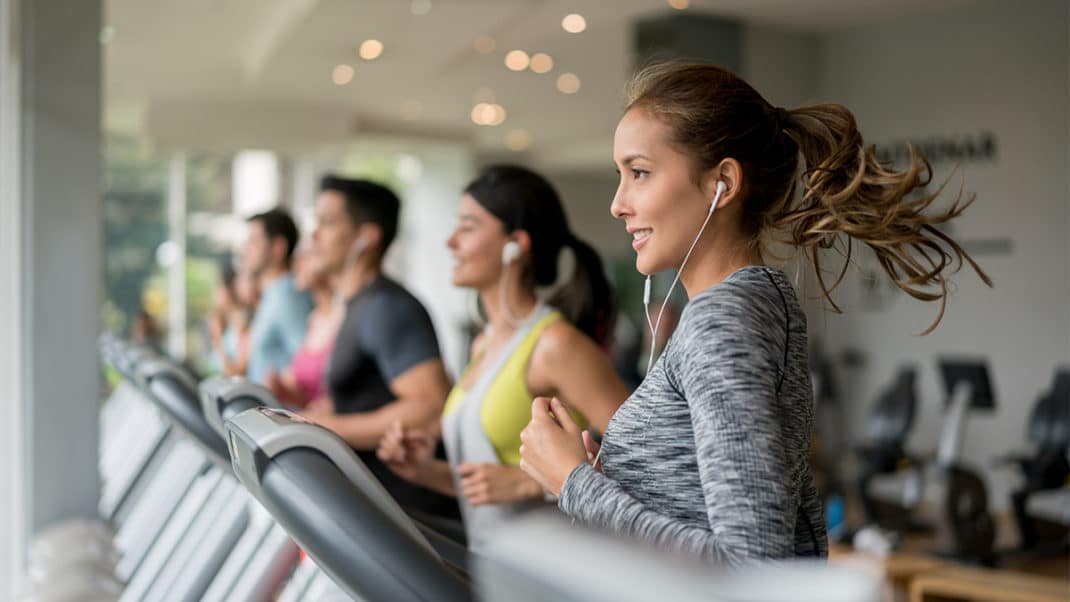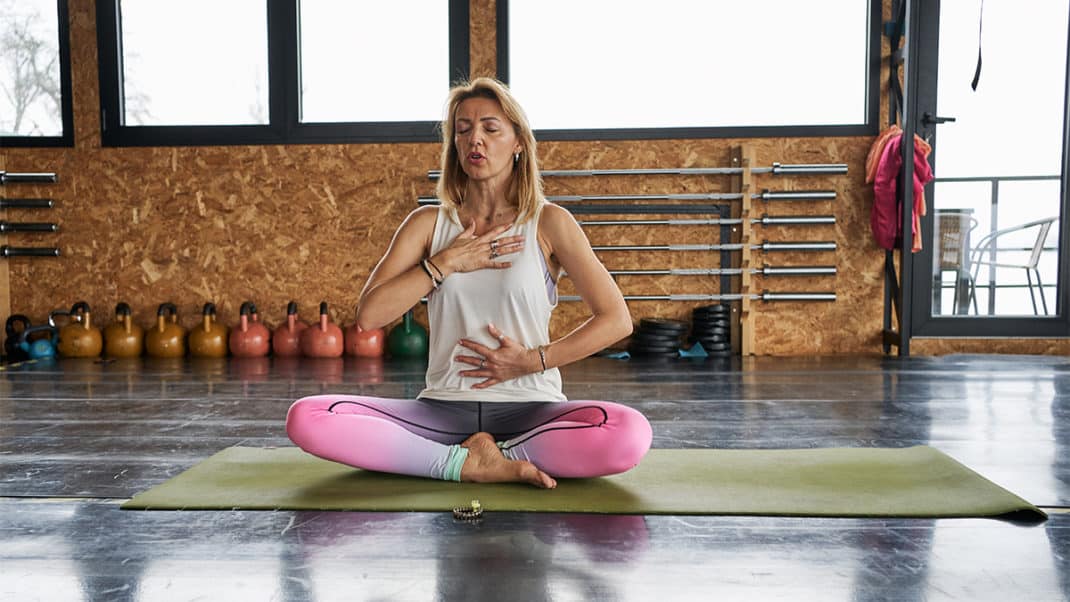Help Clients Return to Training Safely, Smartly
You can’t just pick up where you left off with your clients before a lockdown—apply solid research to ramp up your programming.

While stay-at-home orders due to the global pandemic transitioned many jobs to the home, they also closed the doors of most gyms. Shuttered facilities forced gym-goers to find new ways to keep active from the confines of their homes. Fitness tracking data from the first stages of the coronavirus shows that people were active but fell short with their strength training regimens (see “Physical Activity During Lockdown: Data From Fitness Tracking Devices,” below). It’s safe to surmise that even the most dedicated clients probably didn’t push themselves as hard as they could have done if they’d been working with a personal trainer.
The rolling reopening of fitness centers means that, like bears coming out of hibernation, people want to get back to their regular fitness routines. While many have indeed been active at home, the emphasis on cardiovascular activities—reflected in the tracking data—means they’ve likely lacked the intensity and variety offered in a good gym-based workout. Whether it’s been a few weeks or a few months, personal trainers must update programs to fit clients’ current status, not their pre-coronavirus fitness levels.
Where to Start

Start with an interview, and find out if there have been any changes in medical and/or medication history.
Though they may not be new customers, your clients have been through a lot of change since they last visited the gym or studio. Therefore, begin each comeback experience with a thorough assessment. Resist the urge to skip this step, thinking you know people well enough without it. Maybe the assessment won’t reveal anything new, but chances are it will.
Start with an interview, and find out if there have been any changes in medical and/or medication history, including a diagnosis of COVID-19 (see “Exercise and the Post-Coronavirus Client,” below). Ask thoughtful questions about how clients handled the lockdown physically, economically and mentally/emotionally. It’s possible some of your clients were isolated and alone for a period of time and would welcome the opportunity to connect and share their stories.
The pause caused by the pandemic has allowed people to reflect on life in a new way, so be sure to include a question about goal-setting. What are their new objectives? Priorities may have shifted due to canceled events and more time spent with family. Some clients might choose more function-related goals now. For example, they may want the energy and strength to play volleyball with their kids and go on long bike rides with their partner instead of preparing for a race or losing weight for a high-school reunion.
In addition to your preferred assessment outlined by your accredited certification provider, consider the following actions.
See also: Webinar: IDEA COVID-19 Support Webinar Series: Reopening Our Clubs and Studios, Part 1
Assessment
Take all clients through a thorough assessment of strength, flexibility and aerobic capacity. People may have worked out through lockdown, but their overall fitness capacity may be lower due to decreased total step counts during home isolation. There are a variety of fitness tests to choose from, based on each individual’s goals and status. Remember, the aim is to assess a starting point, not to shame clients for their post-coronavirus condition. Therefore, choose a test that gives you enough information without overwhelming them (see “Fitness Testing,” below, for some options).
The same approach holds true for strength and flexibility testing. Rather than risking belittling clients by asking them to match or exceed their previous one-repetition maximum, start with a 10-RM test. Allow them to experience successful movement against resistance; they’ll feel accomplished and satisfied having done a bit of exercise, without feeling discouraged. Incorporate yoga poses and stretches into the cooldown to help clients feel relaxed and refreshed when they leave the gym or studio. This will also allow you to evaluate overall flexibility status.
Avoid Too Much Too Soon

When loads are consistently too high, the snowballing effects of fatigue can be profound.
Once clients connect with their gym community and get back into a routine, they’ll likely want to jump back in full force. While it’s important to capture this enthusiasm, you might need to rein it in a bit to prevent injury, as training errors cause most athletic injuries (Gabbett 2016). Mistakes in exercise plans place the training load—the amount of work programmed to achieve a desired result—at a level beyond the tissues’ current capacity or below the amount needed for performance (Gabbett 2016; Impellizzeri, Marcora & Coutts 2019). Proper progression is key.
The classic model of activity progression is the acute-to-chronic workload ratio. This ratio measures the amount of training at that time against workload history and allows trainers to monitor spikes in load. The thought is that big changes increase injury risk. Therefore, the recommendation is to advance the training load by no more than 10% of the chronic load at any given time (Gabbett 2016).
There are inherent problems with using this approach to progress programming, however. First, this calculation becomes unrealistic at the low end of the training spectrum. Take the example of someone who is just starting her fitness journey and performs 10 reps of a biceps curl using 8 pounds. To advance her training by 10% the following week, she would need to add an extra eight-tenths of a pound to her biceps curl. In reality, her body can likely handle an additional 2 pounds without injury, even though this increases the load by 25%.
The application of the acute-to-chronic ratio becomes equally impractical when applied to elite athletes. For instance, based on this calculation, a marathon runner who logs 90–100 miles per week should be able to add as many as 10 miles to that training load with a reasonably small risk of injury. That calculation fails to consider the cumulative fatigue from running such long distances weekly. Rather, it sees the chronic estimate as a state of fitness and the acute number as a measure of fatigue (Gabbett 2016). When loads are consistently this high, however, the snowballing effects of fatigue can be profound.
See also: Webinar: Reopening Guidelines from CFA: A Blueprint for IDEA Member Facilities
Another Option: Internal Load
Overall training load consists of the external load that you program—the actual physical work done—and the internal load inherent in the body. Internal load depends on many psychophysiological factors and affects the body’s response to the external load (see “Psychophysiological Factors That Influence Internal Load,” below). For instance, if a client is under stress and didn’t sleep well the night before, his heart rate may be elevated in response to an external load, even if he successfully handled this load previously. The client experiences the same external load but responds differently because of the higher internal load.
Trainers plan external loads to achieve the desired training outcome—improved strength, increased metabolism, better performance, etc. However, internal load is what determines the training result (Impellizzeri, Marcora & Coutts 2019). Thus, cookie-cutter programs don’t achieve the same result for everyone because they don’t take internal loads into account. While measuring objective external loads is easier, tracking a client’s internal load guides programming more appropriately.
Measuring Internal Load
The rating of perceived exertion scale provides a reliable measurement of internal load (Impellizzeri, Marcora & Coutts 2019). The scale allows a client to give feedback on the effort required to complete a task (see “Rating of Perceived Exertion Scale,” above). Beyond each exercise, the session RPE provides feedback on the workout’s intensity as a whole. To calculate training load, wait a few minutes after the session ends and then ask the client, “How was your workout?” Next, multiply the athlete’s session RPE by the duration of the workout in minutes (Haddad et al. 2017). The result is measured in arbitrary units (AU): (training load [AU] = RPE 3 session duration [minutes]). The training load calculated from the session RPE correlates well with the heart rate training zones and is a simple way to measure effort (Haddad et al. 2017).
Heart rate monitoring is another way to measure internal load. HR reflects the impact of psychophysiological factors on the system. An elevated HR early in the session means the body was already under stress and is working harder than usual to handle the external load. True HR monitoring requires multiple HR measurements throughout an exercise session as well as calculation of individual heart rate training zones. While wearable tracking devices make this easier, using HR as an indicator may be too sensitive. Considering that heat stress, dehydration and medication can all significantly affect HR, measurements can vary by as much as 6.5% each day (Halson 2014). Though accurately communicating internal load, HR may not reflect the actual response to exercise. A better measurement might be heart rate recovery.
Heart rate recovery shows how quickly HR returns to its normal resting rate after an exercise bout. This measurement, commonly used to assess fitness, determines HR at the end of the activity and then after 1 minute of rest. At this point, you should note the change in HR. As the client’s training status improves, HR should recover more quickly and thus produce a bigger change. An HR that remains elevated after 1 minute reflects fatigue or higher internal loads.
An elevated session RPE and a high recovery HR likely indicate physical fatigue. However, if HR response seems normal, yet RPE is elevated, the fatigue may be due to any of the psychophysiological factors affecting internal load. If this load is high, the response to external loads will not be optimal. Therefore, you will want to decrease external loads if the client is suffering from high stress, lack of sleep, perceived fatigue or other psychophysiological factors.
Making A Plan

A thorough assessment and close monitoring will help you plan the best program to reach your clients’ goals.
The novel coronavirus pandemic has changed the world forever, including how and why people exercise. Repercussions of the lockdown are socioeconomic as well as psychophysiological. Therefore, clients may carry a more significant internal load as they return to gym-based training. A thorough assessment and close monitoring will help you plan the best program to reach their goals. Utilizing the monitoring data that you gather requires a simple, efficient system for recording individual responses to exercise. Add a spreadsheet to your client binder or virtual folder to quickly log session RPE and HR recovery. Use the 10% rule to advance training when it makes sense, then track the response. Continuously monitor progress and tolerance of training load to avoid injuries and help clients safely meet their goals.
See also: COVID-19 Support Center
Fitness Testing
Following are suggested fitness tests for a post-lockdown return to training. Be cognizant of your client’s ability before choosing a test.
Cardiovascular
- 3-minute step test: for younger people who can easily step up and down
- half-mile or 1-mile walk test: for older clients or those who were sedentary during lockdown
- 6-minute walk test: a variation of the Cooper 12-minute walk test; best for older individuals
- Cooper 1.5-mile run test: useful for athletes and competitive amateurs; offers standardized norms and the ability to calculate VO2max from results (Topend Sports 2008a)
Strength
- 10-repetition max for bench press, squat and other muscle groups
- pullup test for those with a good foundation in upper-body strength
- pushup test, easily modifiable for anyone
- 1-minute situp test, achievable by most people; offers available norms for comparison (Topend Sports 2008b)
- timed wall squat
Flexibility
- sit-and-reach
- toe-touch
- calf flexibility test
- back-scratch test
- straight-leg raise
Exercise and the Post-Coronavirus Client
With well over 5 million people diagnosed with COVID-19 in the United States (as of press time), it’s quite possible that one of your clients has previously tested positive for the novel coronavirus (WHO 2020). Unfortunately, there’s no predictable course of illness with this disease.
Of those who require hospitalization for COVID-19, up to 22% suffer extensive cardiac damage (Phelan, Kim & Chung 2020). Since people who convalesce at home can still be quite ill, researchers aren’t sure of the extent of cardiac injury in the home-based population. Thus, recent recommendations for those who test positive but remain asymptomatic are to refrain from exercise for at least 2 weeks following the test, after which they can slowly resume activity under supervision.
People with a positive COVID-19 test and symptoms that do not require hospitalization should rest for 2 weeks after symptoms resolve. Before beginning an exercise program, these individuals should undergo a complete cardiovascular examination (Phelan, Kim & Chung 2020). Results of this exam will dictate whether they can exercise with supervision or should follow return-to-sport guidelines for myocarditis, which require a more prolonged rest period and additional medical monitoring.
People who were hospitalized likely underwent cardiac testing during their treatment. If not, refer them to their doctor for a follow-up cardiac evaluation. Just as the disease presents differently in different people, the recovery is also highly variable. Some people report having intermittent symptoms for over 2 months after they’ve recovered from the virus (Chuck & Edwards 2020). Therefore, you should monitor your clients and adjust the workout plan based on their internal load as they recover.
Psychophysiological Factors That Influence Internal Load
Internal load consists of the “relative biological (both physiological and psychological) stressors imposed on the athlete during training or competition” (Bourdon et al. 2017). It’s how the body reacts physiologically to the session’s workload. When working with a client who is returning to training after a period of lockdown, factor both internal and external loads into your programming. The following list details a few of the psychophysiological factors that influence internal load (Impellizzeri, Marcora & Coutts 2019; Halson 2014):
- overall health status
- mental health condition
- stress
- nutrition
- fatigue
- sleep
- genetics
- environment
- mood
- perception of fatigue
- perception of exertion
- hormones
- body composition
- age
Physical Activity During Lockdown: Data From Fitness Tracking Devices
As expected, data from Polar watch wearers showed a dramatic decrease in indoor activities like treadmill running and group exercise during March 2020 (Polar 2020). However, Polar wearers in the United States stayed active, choosing running and cycling outdoors instead. Garmin wearers also found ways to continue moving during periods of social isolation. Garmin’s data revealed a dramatic spike in indoor virtual cycling toward the end of March, mirroring a worldwide trend of moving the gym into the home (Garmin 2020a).
Wearable tracking devices showed that although overall step count decreased worldwide during April 2020 compared with April 2019, people were making their steps count. Actions taken during exercise rose by 24%, meaning that if people were going to move, they did so to work out and stay healthy (Garmin 2020b). The data further indicated that the exercise of choice during lockdown was aerobic-based. Walking, cycling and running all proved popular, while indoor strength training workouts were down by 50% (Garmin 2020b).
Despite the challenges of staying fit during the lockdown, it appears many people sought alternative activities. The skyrocketing sales of home fitness equipment seemed to confirm this trend, with a 55% increase in orders of machines and gear for home use in March (Adobe 2020). Surveys conducted in April 2020 found that roughly half of those surveyed exercised about the same amount as they did before the lockdown, and almost one-fourth of respondents reported exercising a bit more after stay-at-home orders went into effect (Statista 2020a). Many of those turned to online instruction: Sixteen percent of surveyed individuals said they watched more exercise videos because of social distancing (Statista 2020b).
References
Adobe. 2020. Adobe unveils first digital economy index. Accessed May 17, 2020: news.adobe.com/news/news-details/2020/Adobe-Unveils-First-Digital-Economy-Index/default.aspx.
Bourdon, P.C., et al. 2017. Monitoring athlete training loads: Consensus statement. International Journal of Sports Physiology and Performance, 12 (Suppl. 2), S2161–70.
Chuck, E., & Edwards, E. 2020. Doctors couldn’t help these COVID-19 patients with their endless symptoms. So they turned to one another. NBC News. Accessed May 17, 2020: nbcnews.com/health/health-news/doctors-couldn-t-help-these-covid-19-patients-their-endless-n1208116.
Gabbett, T.J. 2016. The training—injury prevention paradox: Should athletes be training smarter and harder? British Journal of Sports Medicine, 50, 273–80.
Garmin. 2020a. The effect of the global pandemic on active lifestyles. Accessed May 16, 2020: garmin.com/en-US/blog/general/the-effect-of-the-global-pandemic-on-active-lifestyles/.
Garmin. 2020b. The impact of the global pandemic on human activity: Part III. Accessed May 17, 2020: garmin.com/en-US/blog/fitness/the-impact-of-the-global-pandemic-on-human-activity-part-iii/.
Haddad, M., et. al. 2017. Session-RPE method for training load monitoring: Validity, ecological usefulness, and influencing factors. Frontiers in Neuroscience, 11, 612.
Halson, S.L. 2014. Monitoring training load to understand fatigue in athletes. Sports Medicine, 44 (Suppl. 2), S139–47.
Impellizzeri, F.M., Marcora, S.M., & Coutts, A.J. 2019. Internal and external training load: 15 years on. International Journal of Sports Physiology and Performance, 14 (2), 270–73.
Phelan, D., Kim, J.H., & Chung, E.H. 2020. A game plan for the resumption of sport and exercise after coronavirus disease 2019 (COVID-19) infection. Journal of the American Medical Association Cardiology. doi:10.1001/jamacardio.2020.2136.
Polar. 2020. Polar data: New ways to exercise during lockdown. Accessed May 16, 2020: polar.com/blog/polar-data-exercise-habits/.
Statista. 2020a. Change in exercise habits during the coronavirus (COVID-19) pandemic in the United States as of April 2020. Accessed May 16, 2020: statista.com/statistics/1110985/covid-exercise-habits/.
Statista. 2020b. Effect of COVID-19 on online fitness video usage in the U.S. 2020. Accessed May 16, 2020: statista.com/statistics/1108538/online-fitness-video-usage-during-coronavirus-usa/.
Topend Sports. 2008a. Cooper 1.5 mile / 2.4 kilometer run test. Accessed May 17, 2020: topendsports.com/testing/tests/2-4-km-run.htm.
Topend Sports. 2008b. Sit-up test at home. Accessed May 17, 2020: topendsports.com/testing/tests/home-situp.htm.
WHO (World Health Organization). 2020. WHO coronavirus disease (COVID-19) dashboard. Accessed July 7, 2020: covid19.who.int/.




